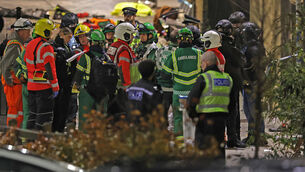UN: Somali refugees dying from exhaustion
A spokeswoman for the UN refugee agency says an unknown number of children under the age of five are dying from hunger and exhaustion as their families flee violence compounded by drought in Somalia.
Melissa Fleming said more than 135,000 Somalis have fled so far this year — including 54,000 in June, three times as many as in May.
She told reporters in Geneva many of those are children who don’t survive the exhausting journey, or who die even after they reach the camps because they arrive so hungry and frail.
More than 800 Somali children arrive each day at the overcrowded refugee camps to escape a devastating drought in their war-ravaged country.
Catherine Fitzgibbon of Save the Children’s Kenya said: “Children have made long journeys in terrifying conditions, often losing their families along the way and arriving at the camps in desperate need of security, health care and a normal life.
“Nearly every child or parent we have spoken to says they are not just fleeing fighting in Somalia — the drought and food crisis are equally perilous to them now.”
The influx of refugees is placing further strain on the Dadaab camps, the world’s largest refugee camps, which were originally built for 90,000 people, but which now house some 370,000 refugees.
The UN refugee agency said last week that 20,000 Somalis have arrived in Kenya in two weeks alone, a sharp increase from last year, when 6,000 to 8,000 Somalis were arriving in Kenya each month.
The group said some families walk in searing heat for more than a month in search of food, water and shelter. Many discard their few possessions along the way.
A mother of four, identified only by her first name Fatuma, told the group that she trekked hundreds of miles for more than a month with her four children.
“The weather was very harsh. It was so hot, and there was very little shelter. I left my husband in Somalia. I do not know if I will see him again,” she told Save the Children staff who interviewed her in the camp. “I am worried for him. The war in Somalia is very bad for families. The drought as well is just too much. We cannot cope.”
The flight of tens of thousands of Somalis had led to overcrowding and occasional violent incidents in Dadaab, as some have erected ramshackle “illegal structures” for housing, United Nations High Commissioner for Refugees (UNHCR) spokesman Adrian Edwards said.
The strain on Dadaab, which is comparable in size to European cities such as Nice and Florence, has led some refugees living there to petition to leave.
The UNHCR, lacking space, has not provided newcomers with plots to live on for three years, though Kenyan authorities have recently established a new site to respond to the overcrowding.
35-year-old mother-of-six, Sahara Abdi said she wants to transfer to the Kakuma camp, three days away.
“We are having problems accessing food, medicine and shelter because many refugees are coming to Dadaab every day,” she said.
American fears of an al-Qaida and al-Shabab resurgence in Somalia has led to increased US military intervention in the country, including a drone strike that wounded two al-Shabab leaders last month.













